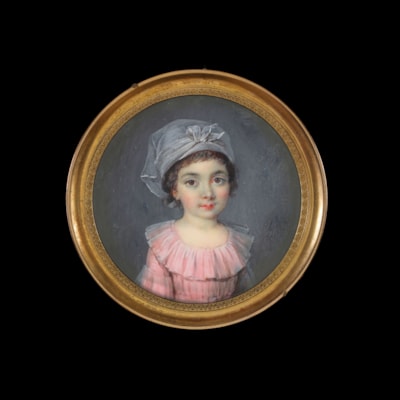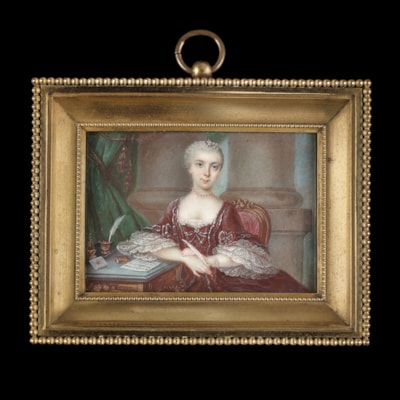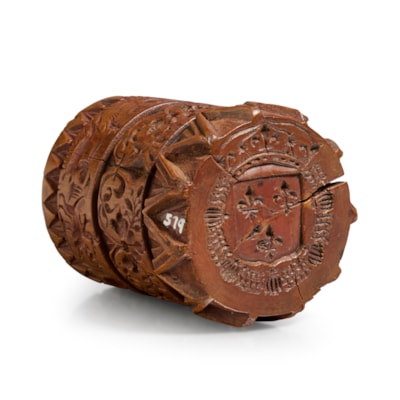FRENCH SCHOOL (18th century)
Portrait miniature of Félix-Louis de Cornette de la Minière, in his prison cell at Château du Luxembourg, wearing a blue coat with red waistcoat and white stock and the Cross of the Order of Saint Louis; 9 July 1794 (22 Messidor Year II)
1794
Watercolour on ivory (licence number: YDXQBLEE)
Inscribed; ‘a la maison d’arrêt du [Luxembourg 21(?) messidor] 2ne de la republique’
Circular, 58mm (2 ¼ diam.)
A note enclosed in the back of the miniature reads:
‘Louis Felix de Cornette de/ Laminière, ećuyer, conseiller du roi,/ secretaire gènèral des dragons de France./ garde des livres de cabinet du roi au/ château de Choisy, trésonier de la/ capitainerie royale de la varenne de/ Louvre. chevalier de St Louis/ né à montmollionle 31 octobre 1733./ condemné à mort par/ Judgement du tribunal revolutionnaire/ en date du 22 messidor an II guillotine/ le mêême jour/ voir page 123 du dossier concernant la conspirationdu Luxembourg= 159 accusé’
£2,500
Before his imprisonment, la Minière had risen through the ranks of the French court. Beginning as the secretary to François-Henri de Franquetot de Coigny (1737-1821), he later became Keeper of the King’s Book Cabinet at Choisy, Secretary General of the Dragoons, and Treasurer of the Royal Captaincy of the Varenne du Louvre. The latter role involved acting as a bailiff for all cases involving hunting and poaching within the grounds owned by the Royal Family in Varennes. This was the same place where, in 1791, the Royal Family were caught attempting to flee from Paris.
It is not clear when la Minière was arrested, but it is known that he was held at the Prison du Luxembourg, housed in the Palace du Luxembourg. The palace had been taken from the Royal Family by revolutionaries and housed some extremely influential prisoners during the time it had been adapted to this purpose. Conditions were not luxurious, but were certainly not as poor as one would expect; prisoners were still allowed their waiting women and gentlemen1.
The prison conspiracies began to take place following the implementation of the Law of 22 Prairial, designed by Robespierre and his allies to strengthen the sentencing power of persecutors. This was voted through in June 1794. Such a law also made it easier to ‘decongest’ prisons through a series of executions. As a part of the conspiracy, certain prisoners were recruited as denouncers and tasked with producing a list of conspirators who would be put on trial. In the case of the Second Luxembourg Conspiracy, this list reached at least 154 names, of which la Minière was one. The tribunals took place over three days, with la Minière’s being on the third. The fate of the prisoners left waiting would have been quite obvious to them, given that fifty-nine out of the fifty-nine accused in the first tribunal were guillotined. The process was utterly unjust, and the Law of 22 Prairial allowed a trial to be conducted without the accused having any means for debate or defence.
Only a year earlier, Marie Antoinette had been executed following her trial, in which she had been accused of treason and incest. For ten months, she had been imprisoned in the Conciergerie in Paris. On 16 October 1793, the Queen was taken on a cart to the Place de la Révolution, wearing a plain white dress. It is said that the crowds lining the street, rather than jeering and throwing objects as they usually would, remained silent as she was taken to her place of execution.
It has been suggested that portraits like this, of prisoners facing death, were produced as a form of bribery. Portrait miniaturists were invited into the prisons to take likenesses that could then be sold by prison guards to the mourning families of those who had been killed. Although la Minière’s wife was not alive when he faced the guillotine, it is possible that his daughter, Adélaïde-Louise-Magdeleine, was the first recipient of this miniature.
1. According to the Journal of the Duchesse de Duras, imprisoned at Luxembourg during the same period (see https://www.gutenberg.org/files/46750/46750-h/46750-h.htm).

shipping notice
Worldwide shipping is included in all prices.
The Limner Company does not accept any responsibility for import duty, this is to be paid by the buyer.
Some stock items contain materials from endangered species which are governed by CITES regulations and will require a permit to export outside of Great Britain. If a certificate of export is required then this will be the responsibility of and paid for by the buyer .
you may also like



 +44(0)7983510056
+44(0)7983510056











